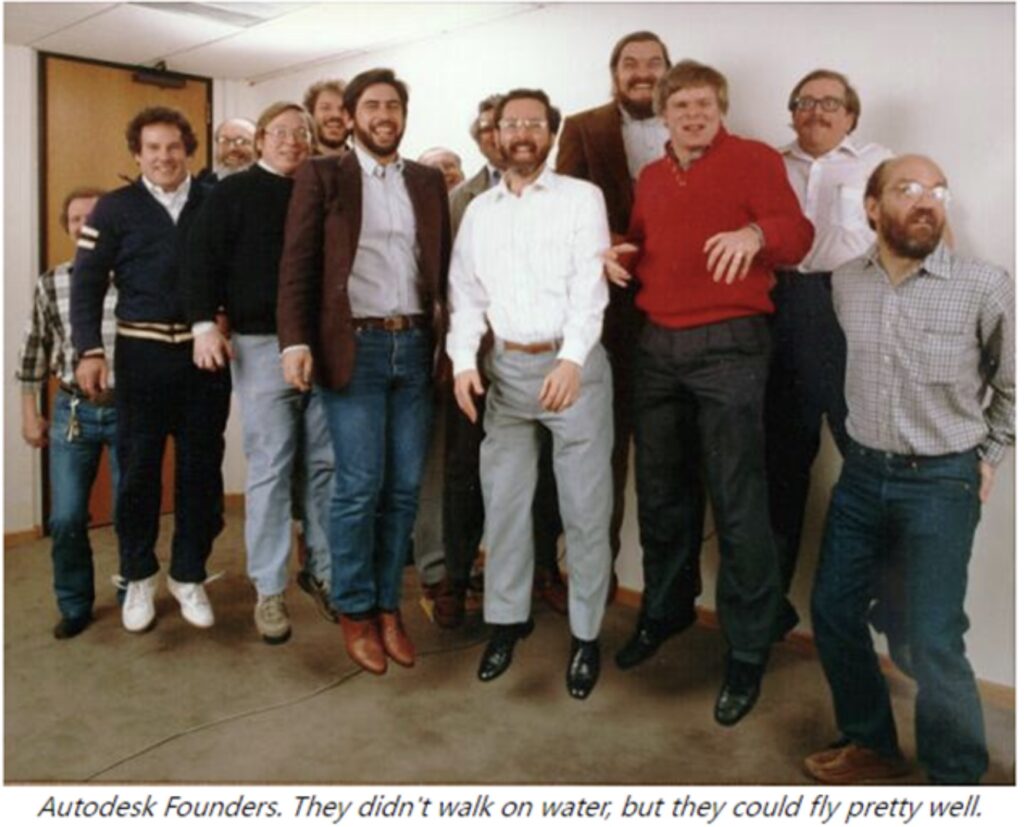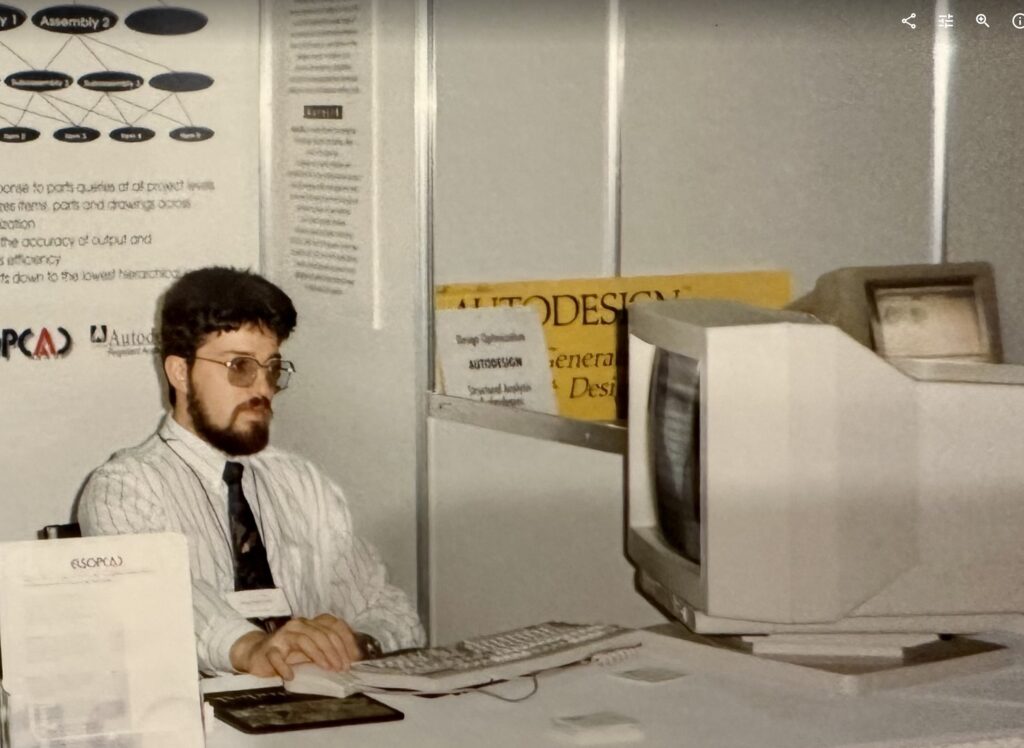Earlier this weekend I read a sad news about passing of John Walker, the founder and the father of AutoCAD and Autodesk. The contribution of John Walker to the development of CAD and PC eco-system was incredible. From early 1980s, Autodesk was one of the biggest software products that demonstrated the power and ubiquity of personal computers. The way AutoCAD was created from both technological and business standpoints was super profound.
To anyone who is interested in CAD, the history of CAD developed, the way of thinking and the work it took to build AutoCAD and Autodesk, I recommend to read Autodesk files. The archive contains essays and they were profound at the time and serve as a very valuable lesson to anyone. I think, they will be valuable to anyone who is thinking about development of engineering and manufacturing software even these days.
Platform Effect – from PC to Windows, Cloud and Internet
One of the most widely mentioned is Information Letter 14 where John Walker speak about changes in CAD world that were happening at the beginning on 1990s. He was calling it – Big, Cheap, Widely available, and Closely integrated with the platform.

My favorite passage is related to “platform integrations” and Windows effect.
What I’m suggesting is that Windows is a Big Event—the kind of thing that happens every decade or so in our industry that establishes a new baseline from which future evolution builds. Events of this nature reward those who move quickly enough to exploit them and winnow out others whose attention is elsewhere, who underestimate the significance of the change, or cannot react in time. Big Events force those who wish to survive to revisit their strategies and question long-term plans. This process requires flexibility in an organisation which is difficult to maintain after it has grown enormously in size and become set in its ways.
One central and virtually unquestioned tenet of Autodesk’s strategy has been “platform independence.” That means, with very few and very limited exceptions, we do nothing on any one machine that cannot be done on every machine that runs AutoCAD. This forces us (some would say “gives us a handy excuse to”) exclude support for many facilities on machines like the Macintosh which virtually all other applications, even the least expensive, furnish. The facilities provided to the AutoCAD user become, in a large sense, limited to the least common denominator of those provided by all the machines we support and look, consequently, crude next to applications closely tailored to a specific system. When we feel compelled to address a glaring shortcoming, such as lack of support of system menus and dialogues, we’re forced into a much larger project such as Proteus, since our solution must work on every machine and operating system, not just one.
Severely limiting the integration of AutoCAD with various operating environments hasn’t hurt us so far, I believe, primarily because the systems that account for the overwhelming percentage of our sales: DOS and 386 DOS, also happen to be the least common denominator in virtually every aspect.
Windows, however, is changing the rules in the very heart of the AutoCAD market. We will, certainly, ship a Windows version of AutoCAD before too many months pass, and we will upgrade that initial product to take advantage of the new versions of Windows now in the pipeline, but I think we have to revisit the level of support we’re planning for Windows. I believe that a similar failure to comply with ground rules for Windows applications may hurt us severely, and every week that passes without our thinking about how to address this problem adds to the danger.
To follow the platform effect was always a strong strategy. Timing is everything. The ability of software to catch the wave of the platform can have a profound effect on every software developer and the history of CAD, engineering and manufacturing software was not an exception. AutoCAD followed PC platform revolution. When John Hirschtick and his team built Solidworks in 1995, they followed the exact timing of the platform effect and Windows platform revolution.
These days, we are following cloud and internet platform revolution, which will bring new platforms once the developers of these platforms will figure out how to make this platform work for them and catch the wave of changes.
From AutoCAD LT Simplification to Modern SaaS products
Another piece of Autodesk files I highly recommend to read was about creation of AutoCAD Lite (LT). The idea and importance of creation of easy and simple package that can protect and expand usage of AutoCAD was important and it still stays relevant for many vendors. The same can be said about possible ways to attack existing vendors bottom up, because this customer segment is always less protected and underserved by entrenched vendors.
With the burgeoning success of AutoCAD, I was increasingly worried about new entrants in the market turning our own strategy against us—entering the market with a low priced package and taking the entry-level user away from us, just as we had done with the big CAD companies. The growing success of the low-priced software market, pioneered by Borland’s Turbo Pascal, only intensified this concern.
This proposal, for “AutoCAD Lite”, was the first real expression of the need for an entry level drawing product in our product line. Of course, we never did implement AutoCAD Lite, but it’s interesting to compare its specifications with those of AutoSketch, which we announced to the world almost precisely two years later. In November 1993, almost a decade after this memo was written, Autodesk announced AutoCAD LT, a $495 subset of the then-current AutoCAD Release 12 (see page ).
The resulting product would be far more usable for the kinds of things people attempt to do with other entry-level programs like Draft-Aide, Robocom, Caddraft, and Cascade I, but should not present serious competition in our present market. Providing an upward migration path to full AutoCAD would lock in the entry level user who purchased the Lite package. (We should, however, think seriously about the possibility that some of the manufacturers and/or Summit might buy this package to bundle as AutoCAD graphics rather than the full package. Would this be bad in the medium run, if purchasers upgraded at dealer price or list? I think some exploratory talks are needed if we decide to do this.)
My Story and Autodesk
My own way with CAD industry started in the middle of 80s when I got access to AutoCAD 2.6 and later AutoCAD 9 was released. The long list of programming features starting from AutoLISP and later ADS, ARX and many others were part of my earlier experiments and work with CAD industry.
Back in 1990s, I was developing applications for architects and mechanical engineers using AutoCAD 10, 11, 12, and 13. I found the picture from one of my first visit to Autodesk when we developed AutoCAD applications and presented them at CAD Camp at Autodesk in San Rafael, CA. Back in those days, the monitors were fat and long and engineers were wearing ties when presented their CAD software.
I had a privilege to work at Autodesk in 2010s, found lot of great friends and colleagues to learn from and made mistakes too. Autodesk is great place to work and learn – I would recommend it to everyone. At OpenBOM, the company I co-founded a few years ago, we are partnering with Autodesk and OpenBOM is integrated with many Autodesk products – Autodesk Fusion360, Autodesk Inventor, Autodesk Revit, Autodesk Platform Services and others.
What is my conclusion?
John Walker, the founder of Autodesk, made a profound contribution to the Computer-Aided Design (CAD) industry by developing AutoCAD, one of the first CAD programs accessible to a wider audience on personal computers. AutoCAD lead the way of democratization in CAD industry by making powerful drawing and design tools available to engineers, architects, and designers, simplifying technology that was previously available only on more expensive and less accessible platforms. John Walker’s vision and innovation not only propelled Autodesk to the forefront of the CAD industry but also fundamentally changed how engineers and architects work. The ideas of AutoCAD platform, simplicity, openness and extendibility are still relevant lessons to everyone building engineering software these days. Just my thought… RIP John Walker.
Best, Oleg
Disclaimer: I’m co-founder and CEO of OpenBOM developing a digital-thread platform with cloud-native PDM & PLM capabilities to manage product data lifecycle and connect manufacturers, construction companies, and their supply chain networks. My opinion can be unintentionally biased.
The post RIP John Walker and AutoCAD Lessons for CAD/PLM Developers appeared first on Beyond PLM (Product Lifecycle Management) Blog.





Be the first to post a comment.